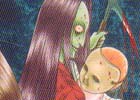Mantis Woman
| Genre: Horror | ||
| Length: 1 Volume | ||
| Allegiance: Bunkasha Publishing/I.C. Entertainment | ||
| Mangaka: Senno Knife | ||
| Vintage: 2003 | ||
| Intelligence Agency Report by: Mana | ||
| Horror Mistress Senno Knife enthralls her audience once again with 6 short horror stories told as “New Japanese Urban Legends.” From the appearance of the long-feared Mantis Woman as a high school teacher, to the mysterious hell of the Zendo family’s basement, to a wish-granting gumball machine, follow the chronicles of various spirited young women faced with all too real horrors in their everyday lives. | ||
|
|
||
| Research Agent Report by: Mana | ||
| Plot Characters Impact Visual |
8.00 7.75 8.50 9.75 |
|
| Overall | 8.25 | |
| (not an average) | ||
| Before I say anything else, I have to admit that I am simply enamored by the horror genre in any and all Japanese media. While your typical American horror films contain the same gyrating slasher plots and undeveloped psychological drama, the Japanese have a tendency to truly put the atmosphere into perspective, and take even the most mundane plots and twist them into something new, exciting and incredibly more enjoyable.
With that established, I’d like to introduce you to Mantis Woman, a manga that managed to intrigue me simply with its cover. If you’re expecting some stereotypical, blood-filled teen cream than please, think again. The best factor about this manga, hands down, is its art. Most genre in the manga world can use a wide variety of art styles to get its point across (heck, just compare some different shoujo styles, like Utena and Sailor Moon to the older and well acclaimed Rose of Versailles), but horror is definitely one genre where this is simply not so (If you need proof of my theory, I refer you to the Ring manga, where they try to take a Japanese horror classic and refit it with big eyes, small mouth teen-styled characters). In Mantis Woman, the artwork fits the story like nothing else I’ve ever seen. It gives each page the dark, creepy atmosphere that Japanese horror is so well-known for, making even seemingly innocent object (Koala stuffed animals, anyone?) look distorted and sinister. My only minor gripe about the art is that most of her main female characters look almost exactly the same. Now, looking beyond all the “oooh… shiny…” artwork, we get to the meat and bones of any manga—its plot and characters. Sadly enough, Mantis falls a bit, here. While each of the six stories is its own, original work, most have predictable endings and recycled effects. Each tale in itself holds new characters, but the stories don’t last long enough for any of them to be developed beyond any straightforward form. Don’t get me wrong, each story is exceptionally enjoyable in its own right; just don’t go into the book looking for anything too innovative or exploratory. All things said, I would definitely recommend this manga to any fan of the Japanese horror genre, or anyone looking for something a bit unique. It is a fast read and more pleasing than it deserves to be. You just may want to keep a good few lights on when you do.
|
||




